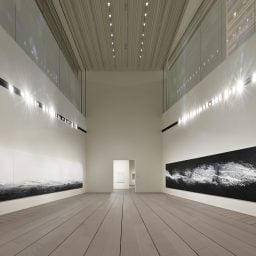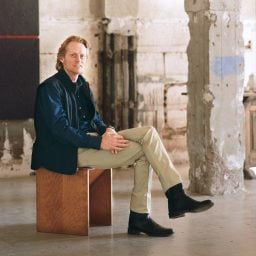Working primarily within the realm of sculpture, Diana de Solares (b. 1952) utilizes a range of readymade and found materials to explore space as a cohesive whole and address the question, “Where are we when we are in the world?” The Guatemalan artist creates sculptures that not only occupy the site where they are presented but help define it. Describing her works as a form of “provisional drawing in space and about space,” she intends them as self-reflexive site interventions that affect viewers’ perceptual experience.
The artist is currently the subject of a solo show with La Galería Rebelde in Guatemala City, “3 de Plycem, 2 de Clavos y 1 Tablón ‘Caos y Eros,’” which is on view through July 28, 2023. Featuring a range of sculptural works made using found materials and objects, the show stages a spatial scene that “seeks to create new relationships and understandings between material bodies and human bodies.”
Recently, we reached out to de Solares to learn more about the ideas behind her current exhibition, and what her process looks like both technically and creatively.

Installation view of “3 de Plycem, 2 de Clavos y 1 Tablón ‘Caos y Eros’” by Diana de Solares (2023). Courtesy of La Galería Rebelde, Guatemala City.
Your solo exhibition is currently on view with La Galería Rebelde, can you talk about the show and the inspiration behind it?
I work with diverse materials and media. Diversity and change are essential to my work and my life. In this show, I have gathered pieces belonging to different series of works. Nevertheless, they are linked through a distinct mindset. “Where are we when we are in the world?” is a recurrent question that underlies my motives for making art. I have been interested in the concepts of chaos and Eros in recent years. Lately, I read a couple of wonderful books that explore those ideas, scientist Ralph Abraham’s Chaos, Gaia, Eros (1994) and psychoanalyst Veronica Goodchild’s Chaos and Eros: The Sacred Mysteries and Dark Shadows of Love (2001). I found amazing revelations in both; they illuminated my understanding of the connection among beings in the world and the importance of myth and Eros for the comprehension of our relationship with the world. I thus used the binomial “chaos and Eros” as a subtitle for my exhibition.
What do you hope the viewing experience is like for visitors? Is there a primary impression or takeaway you would like visitors to have?
It is important for me that the viewing experience transcend a mere visual surprise. I would expect my works to stimulate other senses and emotions in order to elicit a more primary experience of the self, inasmuch as it fits perfectly in the complex puzzle of human life in this planet.

Installation view of “3 de Plycem, 2 de Clavos y 1 Tablón ‘Caos y Eros’” by Diana de Solares (2023). Courtesy of La Galería Rebelde, Guatemala City.
How would you describe your creative process, do you work from a fully formed idea or is it more intuitive?
The starting point of my creative process is an attitude of full awareness of everything around me. This allows me to discover relationships, which are the foundation for my works.
In parallel to my connection to everyday occurrences, I am an avid reader. After a day of work in the studio, I will grab a book that will provide me with synchronic ideas associated to the works in progress.
For example, a recent commission I created for the new U.S. Embassy in Guatemala City was nourished and informed by the poem “Everything is waiting for you” by philosopher-poet David Whyte.

Installation view of “3 de Plycem, 2 de Clavos y 1 Tablón ‘Caos y Eros’” by Diana de Solares (2023). Courtesy of La Galería Rebelde, Guatemala City.
From a technical standpoint, what does your practice look like? How do you choose materials? What do you consider the most important tool in your studio?
I am a builder. I am inclined to common and discarded materials, such as construction debris and sport shoelaces. I have been collecting such things for decades, even before I had decided to begin making art.
Nature around me and atmospheric phenomena are also part of my sources.
My house is totally connected with nature, and I am aware of the variety of sounds of the garden and the volcanoes nearby; the constant transformations in the sky and the wind’s temperature and motion; as well as variations in light throughout the day. Such a mystery and delight!
Such variety of materials and sensory experiences is not enough, because my aim is not to construct a sculpture or a painting per se, but to create a set of relationships among the various elements that I choose to connect. Hence, my sense of spatiality is my most important tool.
You initially studied architecture—does architecture at all inform or influence your artistic practice?
Architecture has influenced my work. I am most indebted to Finnish Architect Juhani Pallasmaa, whose philosophical ideas on art and architecture nourish my vision. Through his writings, I have understood and embraced the need for myth, sensuousness, and Eros in artmaking.

Installation view of “3 de Plycem, 2 de Clavos y 1 Tablón ‘Caos y Eros’” by Diana de Solares (2023). Courtesy of La Galería Rebelde, Guatemala City.
Where do you look for inspiration? Are there any artists or movements—historical or contemporary—that you feel have helped shape your work?
Inspiration comes from varied sources: Vernacular architecture around me, popular objects in streets, roads and markets, daily life unfolding before my eyes. The books I read help me to complement the concepts for each new project.
All that input is translated into an abstract language, which I have understood and embraced since I was a child, particularly geometric abstraction.
Artists, movements, or techniques that have been useful in creating and understanding my work: outstanding developments that occurred in Europe in early and mid-20th century; also, Minimalism, Hard-edged painting, Mono-ha, to name but a few. Artists like Giuseppe Penone, Carlos Mérida, Luis Barragán, Carmen Herrera, Ben Nicholson, Kishio Suga, Abraham Cruzvillegas, are artists that have always awed me, and continue to do so.
Can you tell us what you are currently working on, or would like to work on next?
I am currently working with paper collage from magazines that I have collected for decades. In fact, all my work ends up being a collage of sorts. If 20th century was the collage century, it seems to me that 21st century is even more defined by the reassembling of disparate fragments comprising wholesome images that speak of the charm and efficiency of mixing and “contaminating.”

Installation view of “3 de Plycem, 2 de Clavos y 1 Tablón ‘Caos y Eros’” by Diana de Solares (2023). Courtesy of La Galería Rebelde, Guatemala City.
“3 de Plycem, 2 de Clavos y 1 Tablón: ‘Caos y Eros’” is on view at La Galería Rebelde, Guatemala City, through July 28, 2023.















